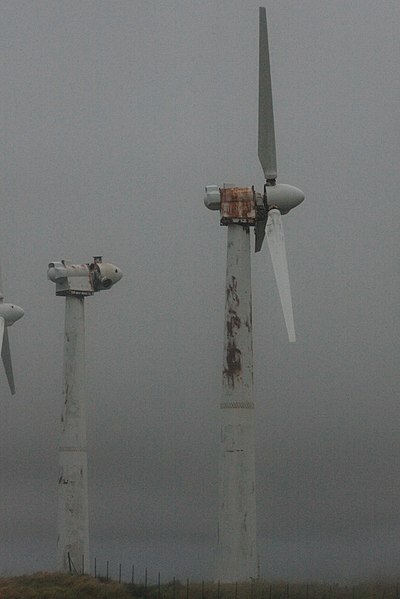The Oklahoma Corporation Commission (OKCC) declared damaged turbine blades and towers at an industrial wind facility straddling the Oklahoma-Texas border in the Panhandle region a threat to public safety following a June 2021 inspection.
Six months later, the OKCC reports the current wind farm owner Olympia Renewable has addressed the safety threats posed by the damaged equipment, by removing some turbines and associated equipment.
Broken Blades, Burnt Nacelles
The 120-megawatt-capacity KODE Novus I and II industrial wind facility, consisted of 60 towers in Oklahoma and 60 across the Texas state line, and associated equipment.
Initially proposed and operated by Novus Windpower, the facility began operating in 2012.
Brandy Wreath, director of the OKCC’s Public Utility Division, conducted the initial site visit and found nine towers with signs of catastrophic failure, with portions or entire blades missing and burnt nacelles at tower tops. Dozens of other towers were locked down, either because of internal damage or for other problems compromising their operation.
“I am not someone whose nerves get on edge very easily, but I didn’t want either myself or my people close to it,” Brandy Wreath told members of the Oklahoma Corporation Commission. “What I saw gave me fear.”
When confronted with the problems identified by the OKCC, company officials admitted there had been numerous problems with the turbines since they were first installed.
The company that constructed and erected the wind turbines, Germany company DeWind, founded in 1995, went through several ownership changes before being liquidated in 2015.
Site Cleanup Completed
After OKCC discovered the problems it issued an emergency order requiring the present owner Olympia Renewable Platform, to develop a site plan to address the problems identified within 30 days.
The company did so, working with landowners and regulators to address the safety threats and restore the wind farm site.
The repair project consisted of removing damaged turbine blades and two damaged towers, clearing debris as well as removing associated buildings and removing electrical cables, other components, for example, concrete and metal foundations to a depth of 48 inches below grade.
Then the company backfilled the soil to restore it to grade and began reseeding disturbed areas to return them to their pre-construction condition.
Company officials explained the initial portion of the job took six months because the contractor could not start work immediately and because the damaged blades could only be removed in low wind conditions. That portion of job is now completed except for the final seeding.
Other turbines had their nacelles and gears replaced, still others remain shut down at present as the company is being forced to manufacture new parts for them from scratch because the original manufacturer, DeWind, went bankrupt.
In the aftermath, OKCC regulators are considering changes to surety requirements to protect landowners in the future.
Texas on the Sidelines
Although half of the wind turbines are located in Texas, the Texas Commission on Environmental Quality (TCEQ) has not visited the property, said Gary Rasp, TCEQ media relations specialist.
“The TCEQ has not conducted an investigation at this site,” said Rasp. “All generators of industrial waste in Texas must properly manage and classify their waste, including managing waste onsite as to prevent nuisance conditions.”
‘Fool’s Gold’
Oklahoma’s embrace of wind was foolish, driven by subsidies and false promises of jobs, said economist Byron Schlomach, who until recently served as director of Oklahoma’s 1889 Institute.
“This facility was developed by a California-based, Korean-owned company that has gone bankrupt,” Schlomach said. “The present owner, Olympia, is based in California; other wind farm owners are based in other countries, including Spain.
“These owners benefit hugely from wind energy subsidies, and those who allow turbines on their land receive lease payments,” said Scholmach. “Rural legislators were initially excited about the jobs from installing turbines, but they were only temporary, like fool’s gold.”
Opposition to wind power is growing in Oklahoma, says Schlomach.
“There is already a great deal of opposition to wind farms,” said Schlomach. “My own community of Piedmont successfully opposed a wind farm whose turbines would have been outside its jurisdiction.
“The state no longer provides tax favors for new wind farms, but it will take time for the 20-year tax favors previously issued to expire,” Schlomach said. “Wind farms are virtually worthless and wouldn’t exist without tax credits and subsidies.”
Duggan Flanakin (dflanakin@gmail.com) writes from San Marcos, Texas.
